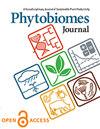Fungal symbionts generate water-saver and water-spender plant drought strategies via diverse effects on host gene expression
IF 3.3
3区 生物学
Q2 MICROBIOLOGY
引用次数: 0
Abstract
Foliar fungal endophytes are known to alter plant physiology, but the mechanisms by which they do so remain poorly understood. We focused on how plant gene expression was altered by six fungal strains that generated "water-saver" and "water-spender" drought physiologies in a C4 grass, Panicum hallii. Water-saver physiologies have lower plant water loss, improved wilt resistance, and higher survival compared to water-spender strategies. We expected fungi within each functional group would have similar effects on P. hallii, and this was largely true for plant physiology, but not for plant gene expression. When we focused only on genes that were differentially expressed relative to fungus-free controls, we found surprisingly little overlap in plant differentially expressed genes or gene regulatory pathways across the fungal treatments, including within and between the water-saver and water-spender strategies. Nevertheless, using lasso regression we identified a small subset of genes that predicted 39% and 53% of the variation in plant wilt resistance and water loss, respectively. These results suggest that fungal effects on plant transcription may identify how they extend the plant phenotype, and the comparison across multiple fungi allows us to differentiate broadly fungal-responsive plant genes vs. those plant genes that respond only to single fungal taxa. The genes identified here could be targeted for future study to understand their function and, ultimately, represent candidates for precision breeding efforts to increase plant drought tolerance.真菌共生体通过对寄主基因表达的不同影响,产生节水和耗水植物的干旱策略
众所周知,叶真菌内生菌会改变植物的生理机能,但它们改变植物生理机能的机制尚不清楚。我们重点研究了六种真菌菌株如何改变植物基因表达,这些菌株在C4草Panicum hallii中产生了“节水型”和“耗水型”干旱生理学。与耗水策略相比,节水生理策略具有较低的植物水分损失、改善的枯萎病抗性和较高的存活率。我们预计每个功能组中的真菌都会对P.hallii产生类似的影响,这在很大程度上适用于植物生理学,但不适用于植物基因表达。当我们只关注与无真菌对照相比差异表达的基因时,我们发现真菌处理中的植物差异表达基因或基因调控途径几乎没有重叠,包括节水策略和耗水策略之间的重叠。然而,使用套索回归,我们确定了一小部分基因,这些基因分别预测了39%和53%的植物枯萎病抗性和水分损失的变异。这些结果表明,真菌对植物转录的影响可能会确定它们是如何扩展植物表型的,通过对多种真菌的比较,我们可以区分真菌反应广泛的植物基因与仅对单一真菌类群反应的植物基因。这里鉴定的基因可以作为未来研究的目标,以了解它们的功能,并最终代表提高植物抗旱性的精确育种工作的候选者。
本文章由计算机程序翻译,如有差异,请以英文原文为准。
求助全文
约1分钟内获得全文
求助全文

 求助内容:
求助内容: 应助结果提醒方式:
应助结果提醒方式:


